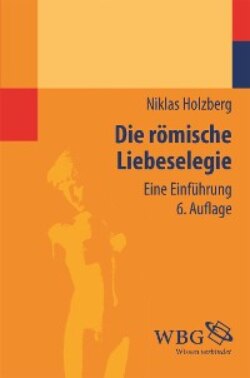Читать книгу Die römische Liebeselegie - Niklas Holzberg - Страница 7
На сайте Литреса книга снята с продажи.
VORWORT ZUR SECHSTEN AUFLAGE
ОглавлениеDie seit der zweiten Auflage erschienene Literatur enthält keine so grundlegend innovativen Ausführungen, daß am bisherigen Konzept etwas geändert werden müßte. Ich verzeichne hier das Wichtigste aus den Jahren 2001–2014, wobei ich mich auf Buchpublikationen beschränke.
GATTUNG: R. ANCONA/E. GREENE (Hgg.): Gendered Dynamics in Latin Love Poetry (2005); M. BAAR: dolor und ingenium. Untersuchungen zur römischen Liebeselegie (2006); F. CAIRNS: Papers on Roman Elegy: 1969–2003 (2007); H. H. GARDNER: Gendering Time in Augustan Love Elegy (2013); B. C. GOLD (Hg.): A Companion to Roman Love Elegy (2012); K. HERRMANN: Nunc levis est tractanda Venus: Form und Funktion der Komödienzitate in der römischen Liebeselegie (2013); S. L. JAMES: Learned Girls and Male Persuasion: Gender and Reading in Roman Love Elegy (2003); M. LOWRIE: Writing, Performance, and Authority in Augustan Rome (2009); C. U. MERRIAM: Love and Propaganda: Augustan Venus and the Latin Love Elegists (2006); P. A. MILLER: Subjecting Verses: Latin Love Elegy and the Emergence of the Real (2003); M. ÖHRMANN: Varying Virtue: Mythological Paragons of Wifely Virtues in Roman Elegy (2008); P. PINOTTI: L’elegia latina: storia di una forma poetica (2002); T. R. RAMSBY: Textual Permanence: Roman Elegists and the Epigraphic Tradition (2007); R. ROTHAUS Caston: The Elegiac Passion: Jealousy in Roman Love Elegy (2012); E. SPENTZOU: The Roman Poetry of Love: Elegy and Politics in a Time of Revolution (2013); T. S. THORSEN (Hg.): The Cambridge Companion to Roman Love Elegy (2013); F. WITTCHOW: Ars Romana. List und Improvisation in der augusteischen Literatur (2009); M. WYKE: The Roman Mistress: Ancient and Modern Representations (2002).
GALLUS: F. HOFFMANN/M. MINAS-NERPEL/S. PFEIFFER: Die dreisprachige Stele des C. Cornelius Gallus. Übersetzung und Kommentar (2009); T. STICKLER: Gallus amore peribat? Cornelius Gallus und die Anfänge der augusteischen Herrschaft in Ägypten (2002).
PROPERZ: Ausgaben: S. J. HEYWORTH (2007); S. VIARRE (2005); G. GIARDINA (22010); D. Flach (2011); Kommentare: S. J. HEYWORTH: Cynthia: A Companion to the Text of Propertius (2007); H. P. SYNDIKUS: Die Elegien des Properz. Eine Interpretation (2011) [zu Buch I – IV]; D. Flach: Properz, Elegien. Kommentar (2011) [zu Buch I – IV]; P. FEDELI (2005) [zu Buch II]; S. J. HEYWORTH/J. H. W. MORWOOD (2011) [zu Buch III]; G. HUTCHINSON (2006) [zu Buch IV]; Monographien und Sammelbände: G. BONAMENTE/R. CRISTOFOLI/C. SANTINI: Properzio e l’eta augustea: cultura, storia, arte (2014); F. CAIRNS: Sextus Propertius: The Augustan Elegist (2006); G. CATANZARO/F. SANTUCCI (Hgg.): Properzio alle soglie del 2000: un bilancio di fne secolo (2002); E. COUTELLE: Poétique et métapoésie chez Properce: de l’Ars amandi à l’Ars scribendi (2005); J. B. DEBROHUN: Roman Propertius and the Reinvention of Elegy (2003); B. GEORG: Exegetische und schmückende Eindichtungen im ersten Properzbuch (2001); H. C. GÜNTHER (Hg.): Brill’s Companion to Propertius (2006); M. JANAN: The Politics of Desire: Propertius IV (2001); W. R. A. JOHNSON: A Latin Lover in Rome: Readings in Propertius and His Genre (2009); A. M. KEITH: Propertius: Poet of Love and Leisure (2008); P. PINOTTI: Primus ingredior: studi su Properzio (2004); C. RAMBAUX: Properce ou les difficultés de l’émancipation féminine (2001); T. RIESENWEBER: Uneigentliches Sprechen und Bildermischung in den Elegien des Properz (2007); M. RUHL: Die Darstellung von Gefühlsentwicklungen in den Elegien des Properz (2001); C. SANTINI/F. SANTUCCI (Hgg.): Properzio tra storia arte mito (2004); DIES.: Properzio nel genere elegiaco: modelli, motivi, riflessi storici (2005); T. S. WELCH: The Elegiac Cityscape: Propertius and the Meaning of Roman Monuments (2005).
CORPUS TIBULLIANUM: Kommentare: R. MALTBY (2002) [zu Buch I und II]; R. PERRELLI (2002) [zu Buch I]; Übersetzungen: J. LILIENWEISS/A. MALMSHEIMER/B. MOJSISCH (2001); N. HOLZBERG (2011) [beide nur Buch I und II]; Index: A. NOWOSAD/D. NAJOCK/H. MORGENROTH (2002).
OVID: AMORES: Ausgabe: A. RAMÍREZ DE VERGER (22006) [Carmina amatoria]; Kommentare: M. B. RYAN/C. A. PERKINS (2011) [zu Buch I]; Übersetzung: N. Holzberg (22014); Monographien und Sammelbände: (a) Ovid insgesamt: M. v. ALBRECHT: Ovid. Eine Einführung (2003); B. W. BOYD (Hg.): Brill’s Companion to Ovid (2002); P. HARDIE (Hg.): The Cambridge Companion to Ovid (2002); DERS.: Ovid’s Poetics of Illusion (2002); F. HARZER: Ovid (2002); N. HOLZBERG: Ovid: The Poet and His Work (2002); P. E. KNOX (Hg.): Oxford Readings in Ovid (2006); DERS. (Hg.): A Companion to Ovid (2009); U. SCHMITZER: Ovid (2001); K. VOLK: Ovid (2010) [dt.: Ovid. Eine Einführung (2011)]; (b) Carmina amatoria: R. ARMSTRONG: Ovid and His Love Poetry (2005); P. J. DAVIS: Ovid & Augustus: A Political Reading of Ovid’s Erotic Poems (2006); G. LIVELY: Ovid: Love Songs (2005); (c) Amores: A. DE CARO: Si qua fides: gli Amores di Ovidio e la persuasione elegiaca (2003); L. LANDOLFI (Hg.): Teneri properentur Amores: riflessioni sull’intertestualità ovidiana. Gli Amores (2007).
| München, im November 2014 | Niklas Holzberg |
